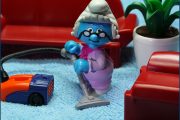We’ve dreamed of a winter wonderland, especially when we were children. Fluffy snow, sparkling icicles, and of course, the snowman. However, reality strikes really hard, with tree limbs, ice dams and cold air. These annoying things will not only cause discomfort in your house, but also be a disaster to your house and your family as well.
The only way you could survive through the winter is preparing a warm coat, hat and gloves for your body and these essential 15 tips to maintain your house. Learning these tips will help you keep your heating and water system effective and reduce the high energy bill.
Welcome to Breathe Quality, where we will give you an up-to-date checklist of winter home maintenance. Preventive maintenance is key to prepare your home for cold weather and we hope these valuable tips will help you withstand winter’s frosty bite.
Breathe Quality Tips & Tricks
1. Install a Door Sweep on Entry Door
Sealing the gap between an entry door and the floor threshold by installing a door sweep is a great way to save energy. Doing this will help you reduce the energy bill both in summer and winter.
Cold winter drafts are able to sneak into your house through this gap between your door and the floor. Sealing off your front door and and any others that lead to the outside with an inexpensive door sweep is necessary
A door sweep is a flexible piece of rubber that attaches to the bottom of the door and closes any air gaps. It is easy to install and prevents the movement of air under the door.
2. Seal Household Cracks and Gaps
Doors and windows are not the only places that winter chills can find their way into your home. Just seal off your door won’t help you prevent the movement of air through any crack, gap or opening around vents, siding, chimneys, plumbing, electrical, the foundation, and basement, etc.
You need to carefully examine your home. Look for damaged or missing sections of siding, cracks in foundations, loose or crumbling brick and rotted wood. With a tube of caulk and an expanding foam spray in hand, you can fix these leaky areas right on the spot. Caulk is cheap, easy to apply and can go a long way towards keeping bugs out.
3. Install Weather Stripping Around Doors and Windows
Sealing your home with tight-fitting weather stripping can make you feel warm all winter long. If the seal isn’t tight, cold air can easily seep in.
The easiest way to check for leaks around your doors and windows is feeling cold air coming in around doors and windows on a windy day. Yes, just that simple.
If you notice that air is coming in around the door or window frame, then a cheap pack of weather stripping is all you’ll need to make the frame air tight. Since the gap size for each leak will vary, weather stripping comes in a variety of different thicknesses so you can easily find the one that’s the best fit.
4. Seal Attic Air Leaks
For many of us the attic is a place that is out of sight and then out of mind. However, small air leaks into attic space are a major source of heat loss in many homes. That’s why you need to seal these air leaks as soon as possible.
Before you crawl into the attic, make a note where anything that goes through the ceiling connected to the attic is located, including of light fixtures, fans, electrical outlets, piping, etc.
Then, go up into your attic and pull back the insulation where you found these spots. Seal small gaps using a silicone caulk and larger cracks with an expanding foam spray. This process works similarly as sealing the household cracks and gaps.
5. Use an Air Purifier
You seal your home. It means your house is stuffed with indoor air quality, mixing both fireplace’s dust and your pet hair and dander. These contaminant things are not good for your health.
To get clean, fresh air back inside your home all you have to do is add a good air purifier. Air purifiers are so good at cleaning the air that they can remove up to 99.97% of impurities from the air around you. Moreover, the air purifier is also good at removing any smoke and odors in your home. Most of the modern air purifiers only consume energy like a light bulb, so you should not worry about the energy bill.
Here are the lists of air purifiers for specific purpose you could find:
List of best air purifiers
- 1, Best Air Purifiers
- 2, Best Air Purifiers for Allergies and Asthma
- 3, Best Air Purifiers for Bedroom
- 4, Best Air Purifiers for Baby
- 5, Best Air Purifiers for Smoke
- 6, Best Air Purifiers for Dust
- 7, Best Air Purifiers for Mold
- 8, Best Large Room Air Purifiers
- 9, Best Air Purifiers for Pets
- 10, Best Air Purifiers for Office
6. Close the Chimney Damper
Do you have a chimney? We all know that we need to open the chimney damper when a fireplace is in use, or smoke will have no where to go but back inside the house.
However, there are many times you won’t use your precious fireplace, and the chimney damper is a big hole for heat to come out and cold air to come in. Consider closing it as long as the fireplace is off, and you will save a huge amount of heat.
7. Have your fireplace cleaned
You’ve done everything to make your home a fortress against the winter outside, but you should never forget about the inner problems. Your fireplace is certain to be used during winter, and regular cleaning for your fireplace is necessary. You could avoid the past fires inside the chimney to cause a house fire easily.
Gas fireplaces should be checked too —even though gas is a clean-burning fuel, there could be an old nest or other debris blocking the chimney.
8. Keep an eye on trees
Big snowfalls can settle onto tree limbs, making them heavy and more prone to breaking — which can be especially dangerous if a tree is within reach of your house.
To avoid these trees, you should do a proper tree maintenance right in the autumn. If you forget to do this, you should use a broom to brush the snow off the tree limbs. Remember to not shake the tree, since this can cause brittle limbs to break.
9. Service the Furnace and Replace the Filter
A dirty furnace is less efficient and will increase your heating bills. You can easily improve your furnace’s efficiency by having it professionally serviced at least every two years. For older furnaces, an annual servicing is advised.
However, not every aspect of furnace maintenance requires a professional hand. In fact, you can do a lot to keep it running efficiently by inspecting the furnace filter on a monthly basis. If you hold it up to the light and and you can’t see through it, then it’s time to have it replaced.
Taking this dirty filter to your local hardware store will make it easier to find the right size replacement.
10. Insulate the Hot Water Heater
If your hot water heater is not new then you’re most likely suffering the loss of standby heat.
Fortunately, you can fix things by insulating the hot water heater tank with a special pre-cut jackets or blankets available from around $20.
Notice these things before you start:
- Be sure that your water heater is not leaking. If your tank leaks, you need a new water heater.
- For an electric water heater, you also might consider insulating underneath the tank as well. A ridged piece of insulation (or bottom board) will help prevent heat loss into the floor, and could save you another 4%–9% of water heating energy. It is best done when installing a new water heater.
11. Insulate the Hot Water Pipes
The hot water pipes that come out of your water heater or steam boiler radiate a lot of heat. Insulating these hot pipes can reduce heat loss and raise your water temperature 2-4°F . This allows you to you to turn down the temperature setting on the water heater to conserve more energy.
Having hotter water inside the pipes also means that you won’t have to wait as long for hot water when turning on a faucet or shower head, thus also reducing your water usage (and bill) too.
A simple work like this only requires a roll of pre-formed pipe insulation and black acrylic tape, both available at your local hardware store.
If you have an electric hot water tank, you can use foam insulation. It is very easy to cut with scissors and wrap around the pipe. If you have a gas hot water tank, you cannot have foam insulation within 6 inches of the flue. You will use fiberglass insulation and wrap it using wire or high temperature aluminum tape to hold it in place.
12. Run the Ceiling Fans backwards
Have you ever noticed that ceiling fans run counterclockwise to produce cool air inside a room? Did you know that you can also reverse the direction of the blades with a flip of a switch?
If this is news to you, you’ll also be happy to find out that running your ceiling fan blades backwards can help heat up a room.
Ceiling fans that run clockwise will lift cold air up and push warm air down. Look for the small toggle switch on the fan body to make this adjustment. Then, run the fan on its lowest setting to enjoy added warmth.
13. Remove window screens
Removing screens from windows can boost natural light and improve solar heat gain.
Also closing the curtains, drapes or blinds can provide much needed insulation from the cold winter air. Keep your window coverings drawn throughout the winter and you’ll notice warmer air inside the house.
14. Have heating system run smoothly
If you notice any strange new noises coming from your heaters, or if one area of the house suddenly seems colder, have the system looked at right away, as these can be signs something is wrong.
A dirty furnace is less efficient and will increase your heating bills. You can easily improve your furnace’s efficiency by having it professionally serviced at least every two years. For older furnaces, an annual servicing is advised.
Taking this dirty filter to your local hardware store will make it easier to find the right size replacement.
15. Install a Thermostat
If you want to maintain your home during winter, you could use the thermostat.
A programmable thermostat can automatically lower and raise the temperature in your house throughout the day and while you’re away. This thing is good at keeping your home warm. To reduce the cost, you should buy a programmable thermostat.
Rating Breathe Quality
-
Average ratings for this post



